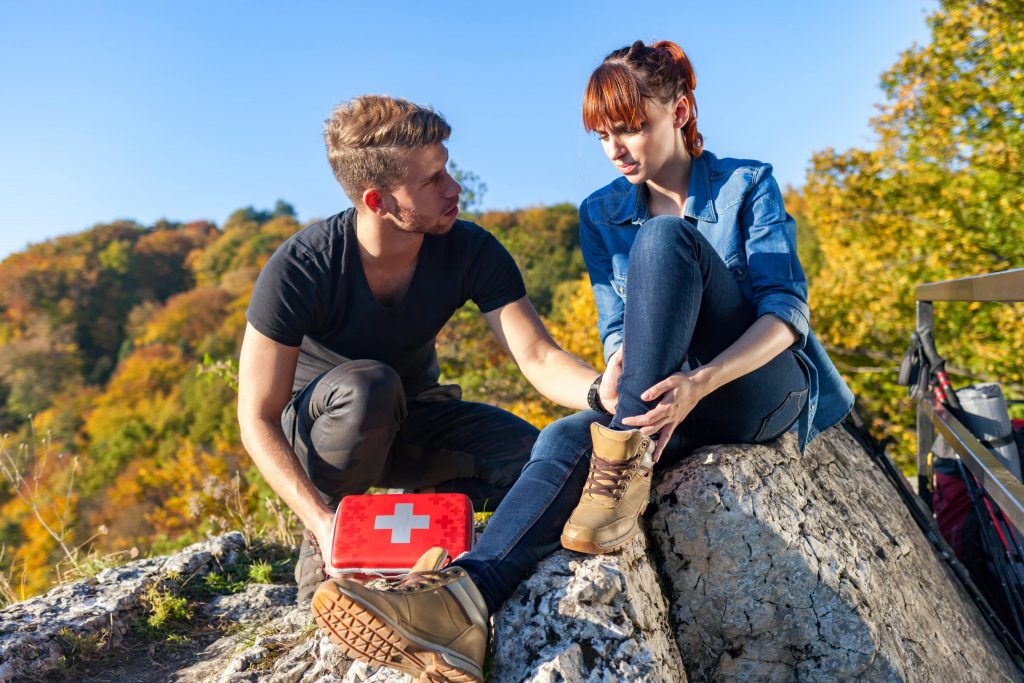First Aid for Hiking Injuries

Although hiking is a fantastic way to see the great outdoors, particularly in isolated locations it may be hazardous. Anytime might bring accidents such sprains, strains, burns, or bites; if you are not near to medical aid, you must be ready. Knowing basic first aid can help you to transform a possible deadly situation into a minor issue unrelated to stopping the trip. This article covers in great depth key first aid guidelines for handling typical hiking mishaps. It demonstrates how learning first aid could reduce hazards and boost safety. Having the correct skills and equipment can help you be ready for the trails and greatly affect your handling of circumstances and hiking enjoyment.
Common Hiking Injuries and How to Recognize Them
Hiking is a fulfilling activity allowing you to commune with the outdoors. However, it comes with some risks that can cause common injuries like twisted ankles, cuts, bruises, and burns. Ankle sprains happen a lot on trails because the ground isn’t always smooth and people can move quickly. To tell if someone has a sprain, look for signs like pain, swelling, and a limited range of motion in the joint. Taking care of a sprain right away is important to keep it from getting worse and to help with the pain, so the walker can either keep going safely or make plans to go home for more treatment.
Another common injury while climbing is getting cut or bruised. This usually happens when someone slips, trips, or brushes against something rough. Cuts are usually easy to spot because they are breaks in the skin that can bleed. Bruises, on the other hand, look like dark spots on the skin that are caused by damage to blood vessels below the surface. When someone gets cut, they should clean the area right away to keep it from getting infected and put a bandage over it. Even though bruises aren’t as bad as cuts, putting ice on them can help reduce pain and swelling. Quick care for these injuries keeps the hiker healthy generally and helps avoid problems, which is necessary to keep going safely on the trip.
Blisters are one of the most common issues faced by hikers, especially on long trails or in wet conditions. They result from friction, usually caused by ill-fitting footwear or socks, and are identified by the formation of fluid-filled pockets on the skin. Although they may seem minor, untreated blisters can lead to significant discomfort and infection, impacting a hiker’s ability to walk. Therefore, it is important to address blisters as soon as they are noticed by cleaning the area and applying a blister pad or moleskin to minimize friction. This proactive approach to injury management ensures that hikers can enjoy their experience without being sidelined by preventable issues.
Basic First Aid for Sprains and Strains
Sprains and strains are frequent injuries that hikers may experience, often resulting from hiking on uneven terrain or losing balance. To manage these injuries effectively on the trail, one should follow the R.I.C.E. method, which stands for Rest, Ice, Compression, and Elevation. This method can help reduce swelling, alleviate pain, and prevent further damage to the affected area. Rest is the first step, and it involves avoiding putting weight on the injured area to prevent further strain. It’s important to find a comfortable position and avoid using the injured limb until it has been assessed and treated.
The next step is Ice, where an ice pack or cold compress should be applied to the injury site to reduce swelling and numb the area, which can help with pain management. Ice should be applied in intervals, typically for 15-20 minutes every hour while ensuring that the ice is wrapped in a cloth or towel to avoid skin damage. Compression follows, involving the wrapping of the injured area with an elastic bandage. The compression should be snug but not so tight as to impede circulation. This step supports the area and further reduces swelling. Lastly, Elevation involves raising the injured limb above the level of the heart. This helps to decrease swelling by allowing fluids to drain away from the injury site.
While the R.I.C.E. method is effective for managing many sprains and strains, it is crucial to know when to seek further medical help. If there is significant swelling, severe pain, inability to bear weight on the injured limb, or if the injury doesn’t improve with initial first aid measures, medical attention should be sought as soon as possible. Additionally, if there is any numbness, discoloration, or the area feels cold, these could be signs of a more serious injury, such as a fracture, and professional medical evaluation is necessary. Prompt attention to these symptoms can prevent complications and facilitate a faster recovery.
Dealing with Cuts, Scrapes, and Blisters
During a hike, minor cuts and scrapes are common occurrences and require prompt attention to prevent infection and promote healing. To properly treat these small injuries, the first step is to clean the wound gently with soap and water if available. This helps remove any dirt or debris that may have entered the wound. In situations where clean water is scarce, using an antiseptic wipe or solution is a practical alternative. Once the area is thoroughly cleaned, it should be left to air dry or gently patted dry with a clean cloth or gauze. After ensuring the wound is dry, applying an over-the-counter antiseptic ointment can further prevent infection. The final step is to cover the wound with a sterile adhesive bandage or gauze pad, which protects it from further contamination.
Blisters can be particularly troublesome during hikes, as they not only cause pain but can also lead to more severe issues if they burst and become infected. To treat a blister, start by cleaning the area with mild soap and water or an antiseptic wipe. Once clean, apply a moleskin pad or blister prevention patch directly over the blister to cushion it and reduce friction. This helps prevent the blister from worsening during continued activity. If the blister is painful or at risk of bursting, it may be necessary to consult a physician after returning home for further treatment.
Preventing blisters is also essential for a comfortable hiking experience. Proper footwear plays a crucial role in preventing these painful injuries. Hikers should select well-fitting shoes or boots that provide adequate support and allow for some room to accommodate foot swelling during long hikes. Additionally, wearing moisture-wicking socks and considering the use of blister prevention patches in areas prone to friction can help reduce the risk of developing blisters. Taking breaks to air out and inspect feet during long hikes can also help catch potential issues early, ensuring a more enjoyable and injury-free adventure.
Handling More Serious Emergencies: Fractures and Heat Exhaustion
When dealing with more severe injuries such as fractures during a hike, it is crucial to act swiftly yet calmly to prevent further harm. Immobilizing the injured area is essential. To do this, create a makeshift splint using sturdy materials like sticks or trekking poles, and secure it with cloth, bandages, or even shoelaces. Ensure the splint extends beyond the joints above and below the fracture site to limit movement. The primary goal is to stabilize the fracture and reduce pain until professional medical help can be reached. It’s important to monitor the injured person for signs of shock, such as clammy skin or a rapid pulse, and to keep them as comfortable as possible while waiting for assistance.
In the event of heat exhaustion, recognizing the symptoms early is key. Signs include heavy sweating, weakness, dizziness, nausea, and a rapid, weak pulse. If someone shows these symptoms, move them to a shaded or cool area immediately. Encourage them to lie down and elevate their feet slightly. It’s important to rehydrate them with cool water or an electrolyte solution, but avoid giving them caffeinated or alcoholic beverages. To cool the body, apply damp cloths to the skin, fan them gently, or have them sip water slowly. Remember, heat exhaustion can progress to heatstroke, a life-threatening condition, so knowing when to call for help is critical. If symptoms worsen or don’t improve within 30 minutes, seek emergency medical attention.
Conclusion
First aid knowledge is essential for hikers, as it equips them with the skills needed to manage injuries effectively and prevent further complications during outdoor adventures. Understanding basic first aid techniques can transform potentially serious situations into manageable ones, allowing hikers to continue their journeys safely. It is crucial for hikers to be prepared by carrying a comprehensive first aid kit and remaining calm in emergencies. By staying informed and ready, they can address any medical issues that may arise, ensuring a safe and enjoyable hiking experience.







